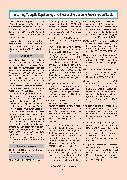Imparting Mosquito Repellent Agents & Assessing Mosquito Repellency on Textile conducted to investigate the toxicity of other impregnated surfaces. The ex- cito chamber also can be evaluated to observe the comparison of mosquito behav- iour on treated and untreated textile. Both methods do not involve human participation. However, the cage test involved hu- man subject as volunteer to test the material may imi- tate the real situa- tion of mosquito biting and may give the accurate results. Conclusion Vector borne disease from mosquitoes are one of the major problem arises. In order to avoid the transmission of dis- eases to other human, fabrics can act as a physical barrier between human skin and the blood sucking mosquito. This review outlines that most com- monly used textile materials to impart the mosquito repellent comes from cotton, polyester and blended fabrics. By using these fabrics, an efficient tex- tile material to treat with the mosquito repellent agent has been proven to demonstrate the good prop- erties. It also showed that there are various techniques of imparting the repellent into the textile substrate which most used methods is a pad dry cure meth- od with microen- capsulation of repel- lents. In this review, it summarized the type of mosquito repellency assess- ment to conduct the efficacy of the impregnated textile. Differences in the findings of the included studies could be attributed to many factors such as type of textile materi- als used or type of technique used to impart repellent. Therefore, it suggested that the suit- able fabrics with a suitable repellent agent with proper methods of mosqui- to repel- lency test is hoped to devel- op a new knowledge to other future study. Competing interests The authors declare that they have no competing interests. References Abou-Donia, M. B. (1996). Neurotoxic-ity resulting from coexposure to py- ridostigmine bromide, DEET, and permethrin: implications of Gulf war chemical exposures. Journal of Tox- icology and Environmental Health Part A, 48(1), 35–56. Agency, U. S. P. E. P. (2007). Reregis- tration eligibility decision (red) for permethrin. Alipour, H., Mahdian, S. M. A., Rami, A., Abad, M. O. K., Amin, M., & Dinparast, N. (2015). Excito-repel- lency effects of Pelargonium rose- um wild (Geraniaceae) essential oil- treated bed nets on the malaria mosquito, Anopheles stephensi Lis- ton, 1901 (Diptera: Culicidae) Amer, A., & Mehlhorn, H. (2006). Larvicidal effects of various essential oils against Aedes, Anopheles, and Culex larvae (Diptera, Culicidae). Parasitology Research, 99(4), 466– 472. Anitha, R., Ramachandran, T., Rajen- dran, R., & Mahalakshmi, M. (2011). Microencapsulation of lem- on grass oil for mosquito repellent finishes in polyester textiles. Elixir Bio Phys, 40, 5196–5200. Anuar, A. A. , & Yusof, N. A. (2016). Potential of geranium from Pelargo- nium Graveolens As natural mos- quito repellent agent in fabric soft- ener. Paper presented at the Fifth International conference on advanc- es in applied science and environ- mental engineering—ASEE. Kuala Lumpur. Appel, K. E., Gundert-Remy, U., Fis- cher, H., Faulde, M., Mross, K. G., Letzel, S., & Rossbach, B. (2008). Risk assessment of Bundeswehr (German Federal Armed Forces) permethrin-impregnated battle dress uniforms (BDU). Internation- al Journal of Hygiene and Environ- mental Health, 211(1), 88–104. Ariffin, Z., Muhammad, N. A., Yusof, R., & Masdar, N. D. (2012). Formu- lation of an aromatic cream: the study on the gera- nium oil proper- ties for the mosquito repellents. NCM-OCTOBER 2021 43Banks, S. D., Murray, N., Wilder-Smith, A., & Logan, J. G. (2014). Insecti- cide-treated clothes for the control of vector-borne diseases: a review on effectiveness and safety. Medi- cal and Veterinary Entomology, 28, 14–25. doi:10.1111/mve.12068. Bano, R. (2014). Use of chitosan in mosquito repellent finishing for cot- ton textiles. Journal of Textile Sci- ence & Engineering, 4, 1–3. doi:10.4172/2165-8064.1000162. Brain, J., Bennett, S. W., Zhen, Y., Pluyter, J. G. L., Popplewell, L. M., & Lee, K. D. (2007). Encapsulated fragrance chemicals: google pat- ents. Brown, M., & Hebert, A. A. (1997). In- sect repellents: an overview. Jour- nal of the American Academy of Dermatology, 36(2), 243–249. Chang, K. S., Tak, J. H., Kim, S. I., Lee, W. J., & Ahn, Y. J. (2006). Re- pellency of Cinnamomum cassia bark compounds and cream con- taining cassia oil to Aedes aegypti (Diptera: Culicidae) under laborato- ry and indoor conditions. Pest Man- agement Science, 62(11), 1032– 1038. Chareonviriyaphap, T., Prabaripai, A., & Sungvornyothrin, S. (2002). An improved excito-repellency test chamber for mos- quito behavioral tests. Journal of Vector Ecology, 27, 250–252. Chen, Y. C., Chung, H. N., & Lin, S. M. (2006). Yarns and fabrics having long-lasting mosquito repellent or antibacterial effect and their prepa- ration: google patents. Division of Vector-Borne Disease. (2012). Den- gue and Aedes aegypti mosquito. San Juan. Farag, S. A., Osama, H., Mohamed, R., & Mohamed, H. (2011). Devel- opment of longer-lasting repellence cellulosic based curtain fabrics. Material Sciences and Applica- tions, 2, 200–208. doi:10.4236/ msa.2011.23025.
